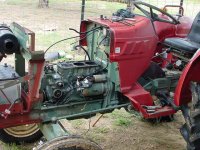Oh and svcguy. I am really particular on how I take care of my equipment as well. My little tractor is showing terriable cosmetic signs but filters, oil changes and grease it has not seen a shortage of.
Funny thing, when I started tearing it down thoughts of a new coat of paint came to mind. However, the realization hit today ,that right now, I hope just to hear it run again.
If the rebuild works out maybe I will treat to a coat of paint.
Funny thing, when I started tearing it down thoughts of a new coat of paint came to mind. However, the realization hit today ,that right now, I hope just to hear it run again.
If the rebuild works out maybe I will treat to a coat of paint.
